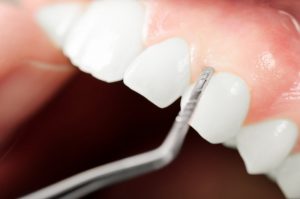
Did you know gum disease affects over 80% of the US population at some point in time? Gum disease is an inflammation of the gums that if left untreated, affects the bone that surrounds and supports your teeth. Usually caused by plaque buildup as a result of poor oral hygiene, gum disease can infect not only your gums, but your teeth too. In its later stages, it can even result in lost teeth. Read on to discover what the stages of gum disease are, the signs to look out for, and how it’s treated by your dentist in Joplin.
What Are the Stages of Gum Disease?
There are three stages of this disease:
Gingivitis
This early stage of gum disease is caused by plaque buildup around the gumline. If you aren’t removing the plaque through daily brushing and flossing, the bacteria in plaque will irritate your gums and cause gingivitis. During this early stage, gum disease can still be reversed, which is why it’s important to catch it early on before it permanently affects your bone and connective tissue.
Periodontitis
During this stage, the bone and tissue that holds your teeth in place have been permanently damaged. Dental treatment and at-home care can prevent further damage, but you may start to see small pockets form that trap bacteria below the gumline.
Advanced Periodontitis
Advanced periodontitis is the final stage of gum disease. During this stage, your teeth begin to shift or loosen because the lack of supportive tissue and bone. If aggressive treatment can’t save them, your teeth may need to be removed.
What Signs Should I Look For?
Because catching gum disease while it’s still in the gingivitis stage means it can be reversed, the key is to catch it early on. Check out these common symptoms of gum disease to stay on top of your oral health:
- Red, puffy, or swollen gums
- Receding gums
- Bleeding gums after brushing or flossing
- Changes in your bite
- Constant bad breath
- Gums that look separated from your teeth
How is Gum Disease Treated?
Treatment will depend on what stage of gum disease you’re in. The early stages can usually be reversed by proper daily brushing and flossing combined with routine cleanings at the dentist’s office.
If plaque has built up into hard tartar, only a dentist will be able to remove it. If your gum disease has progressed to the periodontitis stage, your dentist will use scaling and root planing to remove harmful tartar and get your gums healthy once more. They will scale your teeth to remove tartar and then smooth out your tooth’s roots to prevent further tartar from building up in the gumline.
If you notice any of these signs above, talk to your dentist right away to get treatment before it progresses into the later stages.
Meet the Dentist
Dr. Dan K. Young takes pride in providing high-quality care to his patients. He knows that gum disease is the leading cause of tooth loss in the US, which is why he wants you to understand the stages of the disease and what you can do if you notice any symptoms. For any questions, he can be contacted through his website or by phone at (417) 781-3440.
